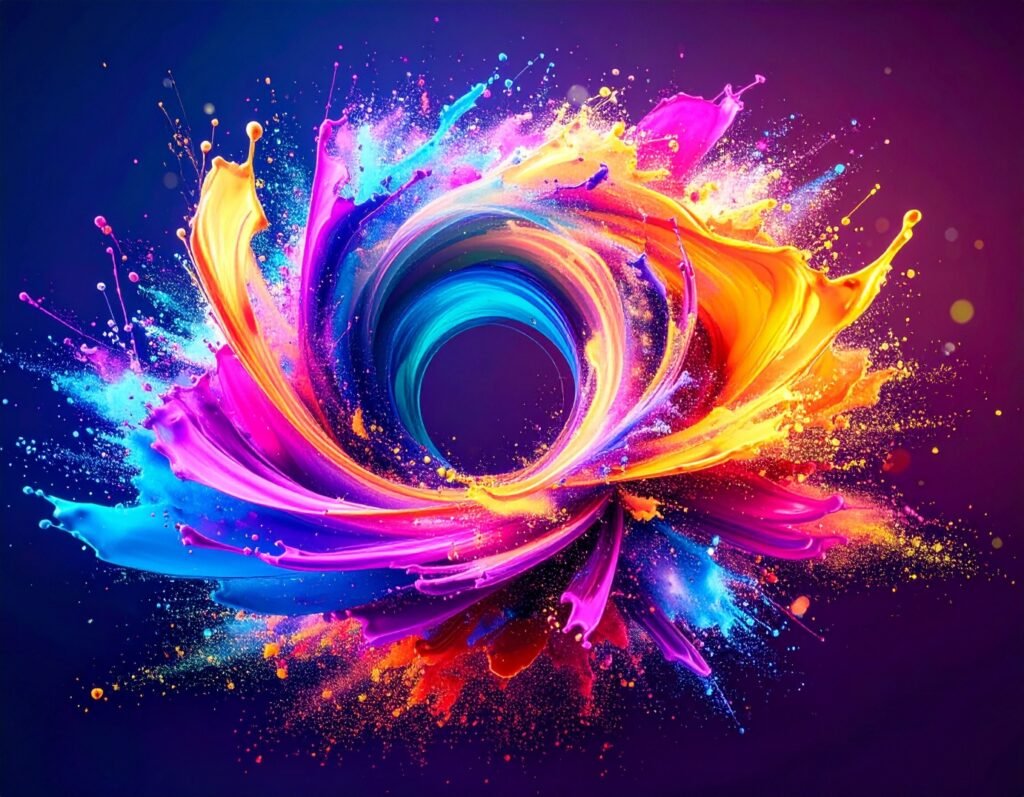The New Language of Digital Storytelling
Scroll. Swipe. Skip. That’s the rhythm of today’s digital consumer. With average attention spans shrinking to just 8 seconds and platforms like TikTok, Instagram Reels, and YouTube Shorts dominating feeds, brands can no longer rely on static visuals to hold attention. According to Cisco’s Visual Networking Index, video content has consistently represented over 80% of all consumer internet traffic, and studies from Insivia show that viewers retain 95% of a message in video compared to just 10% in text. The message is clear: motion has become the language of digital communication.
But motion graphics are more than moving decorations. They are a strategic design tool that clarifies complex information, amplifies brand personality, and improves critical performance metrics such as engagement, retention, and conversion rates. Unlike passive visuals, animated graphics invite interaction, guide focus, and leave a lasting impression.
In this article, we’ll explore the principles of effective motion graphics, their role in enhancing user experience, the technical considerations and accessibility challenges they introduce, and the evolving workflow with AI and AR tools. We’ll also examine real-world case studies — from Dropbox to Netflix — to see how brands are using motion graphics not just to be seen, but to be remembered.
What Are Motion Graphics? (Definition & Scope)
Animated Design with Purpose
Motion graphics can be best understood as graphic design in motion. They take familiar design elements—typography, shapes, icons, and even data visualizations—and animate them to communicate ideas with clarity and energy. Unlike character-driven animation or cinematic visual effects, motion graphics are not about creating fictional worlds or telling long-form narratives. Instead, they excel at explaining, illustrating, and enhancing information in a way that static design cannot.
How They Differ from Other Formats
While live-action videos rely on cameras and actors, and full animation often involves complex storylines and characters, motion graphics sit in the middle ground: they are lighter, faster to produce, and often more versatile. This makes them especially powerful for businesses that want to simplify complex topics or reinforce brand identity without the cost of film production.
Where You See Them Online
On websites, motion graphics appear in many familiar forms:
Hero animations that welcome users on a homepage
Micro-interactions that guide clicks and hovers
Loading sequences that turn waiting into engagement
Explainer loops that visually break down processes
Lottie animations and animated SVGs that are lightweight yet polished
Embedded videos designed for storytelling or tutorials
Together, these elements transform websites from static pages into living brand experiences.
Why Motion Matters for Brands & Marketing
Capturing Attention and Boosting Memory
In a digital world crowded with competing content, motion has a unique edge: it grabs attention fast and helps people remember what they’ve seen. Studies on learning and media retention consistently show that viewers retain 95% of a message when delivered via video, compared to just 10% through text alone. This is why motion graphics have become indispensable for brands that want to cut through the noise and leave a lasting impression.
Driving Social and Advertising Performance
Social media platforms have shifted to prioritize video-first content—Instagram Reels, TikTok loops, and YouTube Shorts dominate user feeds. Animated ads in particular tend to outperform static ones, generating higher click-through rates and engagement. Marketers have noticed: HubSpot reports that the majority of businesses now consider video the highest ROI format in digital marketing. Motion graphics are especially valuable here because they blend storytelling with brand consistency in a way that feels native to these platforms.
Converting Viewers into Customers
The benefits don’t stop at awareness and engagement—motion also drives results at the bottom of the funnel. Research shows that adding video or motion-driven elements to landing pages can increase conversions by as much as 80%, proving that animated storytelling isn’t just eye candy—it’s a revenue driver.
Expressing Personality Through Motion
Beyond metrics, motion is a vehicle for brand personality. As author and designer Val Head has noted, motion “combines form and function” to express not only how a product works but also what a brand stands for. A playful bounce communicates a different identity than a precise, minimal fade—and both can reinforce trust when executed thoughtfully.
Core Animation Principles That Make Motion Effective
Lessons from Classical Animation
While motion graphics often focus on interfaces and branding, they borrow heavily from the timeless rules of classical animation. As outlined in Richard Williams’ The Animator’s Survival Kit, principles like anticipation, timing, easing, and follow-through give movement a sense of natural rhythm. A button that slightly “anticipates” before expanding feels more alive, while easing in and out of transitions mirrors the way real objects accelerate and decelerate, making the experience more intuitive.
UX-Centered Motion Rules
In digital design, motion must serve a purpose. Research from the Nielsen Norman Group emphasizes that animations should provide feedback, orientation, or smooth transitions—never distraction. A hover effect can confirm interactivity, a transition can guide the eye to a new context, and a micro-interaction can reassure the user that their action has been registered. To be effective, these animations must also remain brief and unobtrusive, typically in the 150–300 millisecond range, so they support rather than slow down the experience.
Practical Motion Systems
Modern design frameworks codify these principles into practical systems. Google’s Material Design motion guidelines, for instance, recommend using consistent easing patterns such as “ease-out” for entering elements and “ease-in” for exiting ones. Many teams now adopt motion tokens or reusable animation presets, ensuring consistency across platforms and saving time in production. By applying these structured approaches, motion becomes not just decorative but a functional layer of UX that aligns design craft with brand voice.
Where Motion Helps UX and Conversion (Practical Use Cases)
Micro-Interactions That Build Trust
Small details make a big difference. Animated buttons, toggles, or form validation cues give instant feedback, improving the sense of responsiveness. A subtle shake for an incorrect password field, for example, communicates error clearly without relying solely on text.
Page Transitions and Navigation
Seamless transitions reduce cognitive load by guiding users smoothly between states. Instead of a jarring page reload, a fading or sliding effect helps users maintain orientation, making complex sites feel more intuitive.
Hero Animations and Explainers
First impressions matter. Animated hero loops or short explainer sequences quickly communicate a brand’s value proposition, often in under 10 seconds. This is particularly effective for SaaS companies and startups trying to clarify their offering at a glance.
Animated Data Visualisation
Static charts can overwhelm. Motion highlights key patterns, trends, or comparisons in a way that’s easier to digest. For example, an animated bar chart race can transform raw numbers into a compelling narrative.
Marketing Channels That Drive Action
In advertising and outreach, motion consistently outperforms static content. HubSpot reports that brands using video-based or animated ads enjoy 20–30% higher click-through rates, and animated social posts see far greater shares. Even in email marketing, a lightweight GIF preview or animated call-to-action button increases engagement significantly.
By enhancing clarity, reducing friction, and amplifying storytelling, motion graphics directly contribute to both better UX and stronger conversion outcomes.
Technical Trade-Offs & Engineering Best Practices
Performance Comes First
The best animation is one the user barely notices—because it feels seamless. To achieve this, developers should avoid animating layout properties such as left, top, width, or height, which force the browser to recalculate layouts and cause “jank.” Instead, use transform and opacity, which are GPU-accelerated and align with Core Web Vitals performance goals. Smooth 60-fps rendering isn’t just aesthetic; it directly impacts user satisfaction and bounce rates.
Choosing the Right Formats
Different use cases call for different tools. Lottie animations (JSON-based) are lightweight and scalable, ideal for app and web interfaces. Animated SVGs shine for icons and logos with clean vector paths. CSS transforms and the Web Animations API are best for subtle UI transitions. For richer storytelling, compressed MP4 or WebM video works well, but should be optimized for bandwidth.
Progressive Enhancement and Accessibility
Respect user conditions. Heavy autoplay videos can frustrate users on slow connections, so use lazy loading and serve reduced-motion versions where possible. Modern browsers support “prefers-reduced-motion” media queries, allowing brands to offer inclusive alternatives.
Measuring What Matters
Motion should be tested like any other design element. Profile frame rates and load times, and A/B test variations to see their effect on engagement or conversions. The data ensures animations are not just visually polished but also strategically effective.
Accessibility & Inclusivity
Respecting User Preferences
Motion should never come at the cost of comfort. Many users set accessibility preferences—such as prefers-reduced-motion in operating systems or browsers—to limit animation effects. Designers and developers must honor these signals, ensuring users who opt out of motion are not overwhelmed or excluded.
Designing Without Discomfort
Animations that rapidly zoom, spin, or shift the viewport can trigger vestibular disorders or nausea. To stay inclusive, keep motion subtle, brief, and purposeful. Instead of large panning movements, rely on fades, opacity changes, or gentle scaling that avoids disorientation.
Alternative Content Options
When motion is turned off, the core message should remain intact. Provide static diagrams, readable transcripts, or alternative layouts so the user still receives the full experience, just without the animation layer. This ensures accessibility compliance while safeguarding brand communication.
A Practical Testing Checklist
Before publishing, teams should run through an accessibility checklist:
Verify full keyboard navigation works with or without animation.
Confirm screen reader compatibility, ensuring descriptions flow logically.
Test reduced-motion modes to confirm animations are disabled or replaced.
Accessibility isn’t an afterthought—it’s a mark of thoughtful, user-centered design that broadens reach and builds trust.
A Practical Workflow for Brand-First Motion
Strategy and Goals
Every successful motion system begins with clarity of purpose. Teams should first define the role of motion within the brand: is it providing feedback, establishing hierarchy, or adding moments of delight? Anchoring animation to business and design goals keeps it from becoming decorative noise.
Motion Tokens and Design Systems
Consistency is key. Leading frameworks like Material Design recommend using shared motion tokens—durations, easing curves, and transition types—that apply across products. Whether in a global design system or a lightweight brand style guide, these tokens ensure animations feel cohesive and intentional.
Prototyping Tools
Prototyping bridges imagination and execution. Tools like Figma support lightweight motion previews, while After Effects paired with Bodymovin/Lottie exports animations into scalable JSON files for development. For interaction-heavy prototypes, tools like Principle or Framer let teams simulate real-world usage scenarios.
Handoff and Engineering
Smooth collaboration requires precision. Designers should package handoffs with JSON or CSS snippets, annotated motion specs, and accessibility notes so developers can implement animations faithfully without guesswork.
Testing and Iteration
No motion system is perfect on the first try. Teams should rely on user testing, A/B experiments, and performance profiling to refine animations until they balance brand personality with usability and performance.
Real-World Examples & Lessons Learned
Dropbox — Reframing Utility with Motion
Dropbox’s “Do More Than Store” campaign combined smooth 3D visuals with glimpses of real product use. The animation unfolded at a deliberate pace, supported by a calm voiceover. Rather than pushing storage as a commodity, it repositioned Dropbox as a creativity enabler.
Lesson: Motion can reshape perception by pacing storytelling around new value propositions.
Slack — Turning Chaos into Clarity
Slack’s motion-driven spots often visualize noisy, disorganized communication that gradually transforms into streamlined workflows. With minimal copy and strong animated metaphors, the message is instantly clear.
Lesson: A visual metaphor, executed through motion, can sell complex solutions with elegance.
Google Gemini — Humanizing Technology
Google’s Gemini launch blended live-action with 2D and 3D motion graphics. Layered pacing and thoughtful sound design softened advanced AI concepts, making them more approachable to a broad audience.
Lesson: Hybrid motion formats make technical products feel relatable and human.
Calendly — Expressing Brand Evolution
When Calendly rebranded, it introduced bold shapes and animated color transitions to reflect growth and flexibility. The motion graphics amplified the refreshed identity across digital channels.
Lesson: Motion isn’t just decoration—it communicates transformation during brand evolution.
InDrive — Brevity with Impact
InDrive ran a six-second ad built around a single animated metaphor for clarity. The message was unmistakable, proving long runtime isn’t necessary for resonance.
Lesson: Brevity plus clarity makes motion highly effective in fast-scroll environments.
Burger King — Breathing Life into Rebrands
Burger King’s identity update leaned into retro-modern animation, extending its bold visual style into digital and social experiences. Animated typography and playful transitions kept the brand fresh.
Lesson: Motion helps rebrands live dynamically across channels, not just on static assets.
Emerging Trends to Watch
AI-Assisted Motion Design
Artificial intelligence is transforming workflows by automating repetitive animation tasks and accelerating prototyping. Designers are adopting AI-driven tools to generate transitions, suggest easing curves, and even adapt animations for multiple screen sizes. Industry reports highlight a rapid uptake of AI in design studios, where it is freeing creatives to focus on storytelling rather than mechanics.
3D Motion & Real-Time Engines
Three-dimensional motion graphics, powered by engines like WebGL, Three.js, and Unity, are increasingly used for immersive web experiences. These tools allow brands to deliver real-time, interactive visuals that elevate everything from product showcases to portfolio websites.
Interactive and Scroll-Driven Motion
Scrollytelling—where animations unfold as users scroll—has become a popular way to create deeper engagement. By linking motion directly to user actions, brands can guide attention, simplify information, and build memorable digital journeys.
AR and Immersive Motion Experiences
The global augmented reality (AR) market, valued at over $62 billion in 2023, is projected to grow at nearly 40% CAGR through 2030. As AR matures, motion graphics will be critical in blending digital and physical spaces, from retail try-ons to location-based storytelling.
Quick Practical Checklist
Define the purpose of each animation—feedback, transition, or delight.
Establish motion tokens: consistent durations, easings, and patterns.
Use GPU-accelerated properties (transform, opacity) to optimize performance.
Honor user preferences with
prefers-reduced-motionand accessibility settings.Test animations with real users and gather feedback.
Reuse assets efficiently with Lottie or JSON-based animation libraries.
Prioritize brevity: keep motion unobtrusive and contextually relevant.
Track metrics: measure load times, frame rates, and conversion impact.
Conclusion
Motion graphics are far more than decorative flourishes—they are strategic tools that clarify complex ideas, convey brand personality, and drive engagement, retention, and conversions. When applied thoughtfully, with attention to accessibility, performance, and user experience, motion transforms static websites and interfaces into memorable, interactive brand experiences. From micro-interactions to hero loops, motion can guide, delight, and influence users across every touchpoint.
For teams ready to get started, consider creating a motion brief, trialing a single hero animation, or building a set of reusable motion tokens for your design system. By integrating these practices, you can harness the full potential of motion graphics in your branding and marketing efforts.







